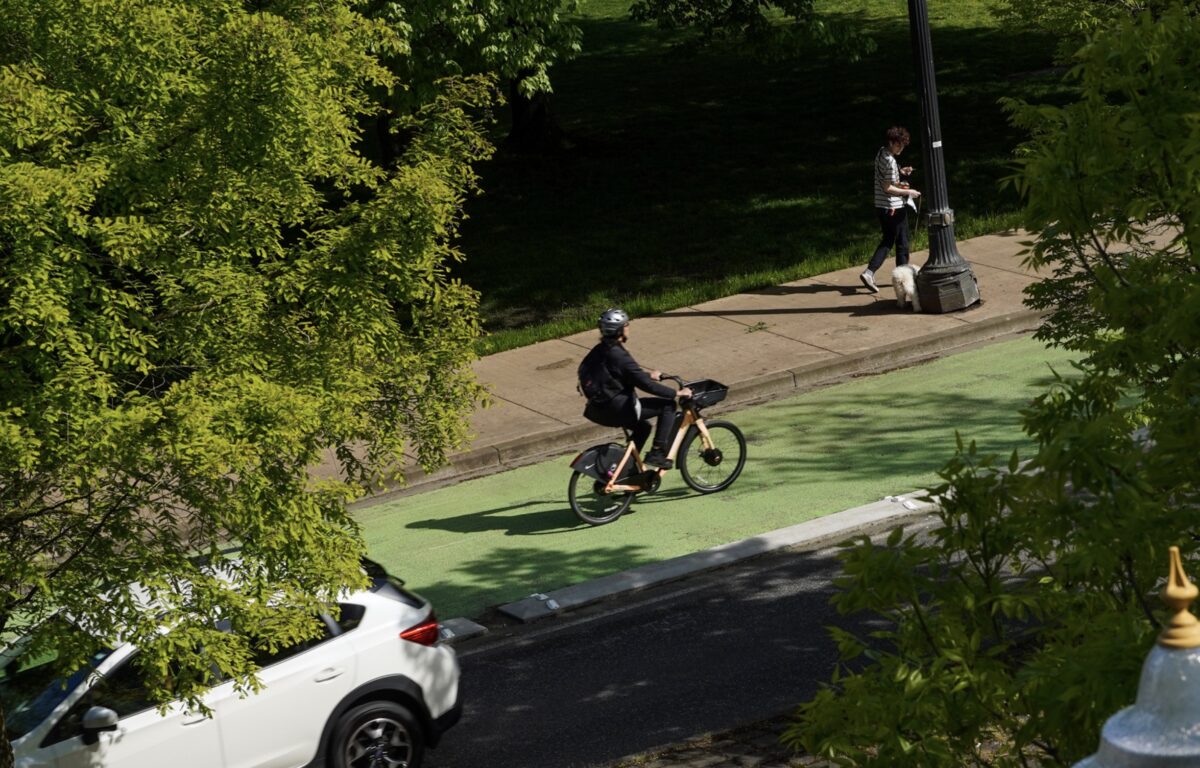
What has the pandemic done to Portland bike traffic?
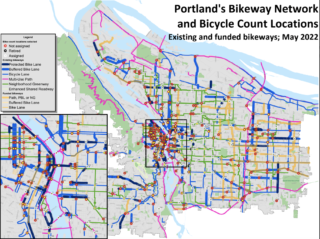
The City of Portland’s transportation bureau hopes to find out when they re-start their official summer bike counts for the first time since 2019.
Manual counts of bicycle riders have been performed by PBOT since 1992 and have been an invaluable source of data for planners and advocates. While not a scientific sampling, the counts illustrate overall trends in both rider demographics and geographic ridership patterns.
As they prep for the 2022 counts, they’ll assign volunteers to over 300 strategic locations to help pull it off. According to an email by longtime PBOT Bicycle Coordinator Roger Geller, the data collected this year will include bike turn movements, rider gender and helmet use.
Advertisement
Geller also pointed out the city has added 48 miles of additional bikeways since the last count in 2019. “It’s time to go out and see how Portlanders have responded [to this new infrastructure],” Geller writes.
But new infrastructure isn’t the only thing Portlanders will have responded to. With more people working from home, the number of bike commuters is way down, so bike count locations will reflect different types of bike trips than in the past. For instance, in April 2020 Geller told the city’s Bicycle Advisory Committee that trips across the Hawthorne Bridge (a popular connection to downtown jobs) were down 56%, while trips on the Tilikum Bridge (a popular weekend riding route) were way up.
At the same time, the number of car users on Portland roads has increased — and the behavior of many of them has gotten worse (if speeding data and myriad anecdotes are any indication).
The city conducts bike counts in other ways, too. Every time a person on a bike rolls across the Tilikum Crossing, they add a tally to the daily count. And although the bike counter across the Hawthorne Bridge is essentially defunct to the layman observer, PBOT is still receiving data about how many people are crossing that bridge, too.
The data collected this summer will add to those tallies to help PBOT figure out how and where to improve Portland’s bike network.
Bike count volunteers sign up for two-hour shifts at a specific site, typically on a weeknight between 4:00 to 6:00 pm. About 100 sites have been snagged so far, so there are now about 200 to choose from, well-dispersed around the city.
Check out the list of sites on this Google Spreadsheet. Visit the PBOT Summer Bike Count website to learn more and if you want to secure a volunteer spot, email roger.geller@portlandoregon.gov.


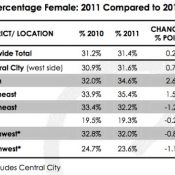
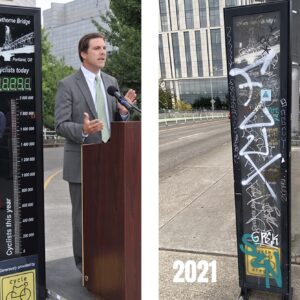
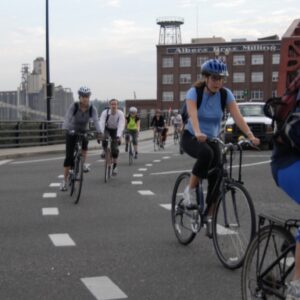

Thanks for reading.
BikePortland has served this community with independent community journalism since 2005. We rely on subscriptions from readers like you to survive. Your financial support is vital in keeping this valuable resource alive and well.
Please subscribe today to strengthen and expand our work.
My 5 o’clock commute today through Downtown and into N/NE was the most bike traffic I’ve seen in my 11 months here.
I still ride, but not where/when I’d be counted.
Since many people are working from home now, they should be also counting during mid day when people leave for lunch or go do errands
they what ? from home ?
Thanks Jonathan. The best way to volunteer is to send me an email at roger.geller@portlandoregon.gov!
Website is not yet, but will be updated.
Huh? Where?
I don’t see any 2019 bike count data on that page or on the google spreadsheet.
The Tilikum bike counter suggests that counts were down in 2020 and way down in 2021 and the first 4 months of 2022. These counts appear to support my anecdotal observation that cycling in Portland has cratered.
http://portland-tilikum-crossing.visio-tools.com/
(The May 2019 upwards blip was due to a one time event.)
Anecdotally, I ride around NE Portland 10-15 miles a day and the bike lanes and Greenways have less cyclists than 5 years ago. Probably demographics as much as anything. The Williams/Vancouver streets are way less than a few years ago. More dangerous now I think since cyclists no longer stand out and cars ignore you again.
$5 dollar gas may make a difference I hope as maybe the more affluent demographic that moved in will take notice of the Bike lanes again.
you should waste our time counting hourly semi traffic on the 5. they carry FOOD not votes.
How will the count determine riders’ genders?
By profiling.
The gender denotation is by best guess of the observer. And yes there’s bias and yes it’s a binary option — the difficulty with changing the criteria is consistency with the long-term dataset (as noted this data has been collected for 30 years now!). And there will continue to be the bias of the observer.
I strongly recommend signing up to volunteer, going through the training, and counting an intersection. It’s fun! And just good to get a feel for the challenges in data collection.
Just so we’re clear, this count does not record riders’ genders. It records their perceived gender performances, forced into a binary scheme. What is the value of this? That we have thirty years of mislabeled data doesn’t make the data better. Seriously, I am not trying to be (too) provocative. What is the value of knowing that counters think x number of riders perform as female and y number of riders perform as male? Will there be an “I have no idea” option for the counters?
could it be because of the assumption is that men are strong and fearless and women need to be coaxed on to bikes? I am supporting that assumption, but it seems to be underlining Geller’s bike classification system.
It probably has to do with how dude-presenting-types ride dangerous infrastructure at higher rates than non-dude-presenting-types. Could be a proxy for perceived dangerousness of certain routes by comparing M/F binary ridership in specific places to M/F binary ridership rates in total. That’s tough data to capture directly.
This is a great question and really awesome of you to question the ‘status quo’. FWIW, another data point is if the person is wearing a helmet or not, which has some interrelated crossover with perceived gender, IMO. In the past 4 years that I’ve done counts, I’ve observed interesting differences in perceived gender and where people are actually riding — there’s one intersection that I count that is the confluence of a greenway crossing a road with door-zone bike lanes. I observe more female-presenting folks, often with kids, on the sidewalk at this location (often without helmets) compared to those ‘on the road’. I think this does say something about usability and perceived safety of the options.
If I were going to add something to the count I’d love to see an age category. Again it would be subjective by the observer, but something really generic like ‘adult’ and ‘child’.
Given that these counts are done at 300-ish locations around Portland by volunteers and that there IS really great value in long-term data sets to look at longer trends (in location and just quantity of cyclists), would you recommend that PBOT just drop the gender designation? Or change it how? Because just like workforce participation, I do think we’re missing something societally if we only have strong participation from the male-presenting part of our society in an activity. And I’d like to know of how we could measure that, in this instance.
I wish we would stop focusing on commuting. The rest of this is a guess…but I assume that people’s commutes are the longest distance they travel on a regular basis. If we want more people to bike, then focus on every other, shorter trip. It seems easier to get people to ride a mile or two near their homes for normal errands than a long trip. I know that’s not true for everyone (and I realize commuting has such a bigger impact). But the amount of people that drive less than two miles (outside of commuting) has to be pretty large. Related to the bike count…only counting normal rush hour doesn’t track all those other trips, or the number of kids riding from school. We want a bike system that supports all ages but spend a lot of time counting and talking about commuters.
Roger Geller was not focused on “commuting” when he claimed that Tilikum bike counts were way up in early 2020 (it’s not clear what data he was using).
Tilikum bridge counts (which are not biased towards commuting) show a modest decrease in 2020 vs 2019, a sharp decrease in 2021, and another decrease for the fist 4.5 months of 2022.
Anecdotally, the schools I bike by 5-6 times a week have racks that are either empty or have 1-2 bikes (most often adult sized bikes). This stands in sharp contrast to the zeroes and 10s when these bike racks often had 10-20 bicycles with many child-size bicycles.
It’s my opinion that cycling advocates/cycling-friendly people are denying the diminished state of cycling in PDX and engaging in magical thinking (e.g. that a goal of 25% bike mode share in 7.5 years is remotely possible). How can we reverse the cratering of transportation cycling if many are unwilling to acknowledge that it’s in crisis?
I don’t disagree. The numbers outside of rush hour and commuting could very well be bad. My point is that we should get that data and then focus on improving those numbers instead of only seeming to care about biking to work.